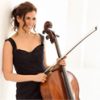
If it Ain’t Baroque, Don’t Break It? Thoughts About Playing Bach Today….
Inbal Segev
When I decided to record the Bach cello suites a couple of years ago, I started not by playing but by reading. I read Bach’s biography, and then a few Baroque practice books (extremely dense and quite boring) and then I became inspired to change almost everything about the way I played Bach. I eventually came back to doing things the way that had been a part of my DNA after years of playing Bach the “modern” way (but improved), and I’d like to share some of my experiments with you.
I never played from a manuscript copy before. The notes are difficult to decipher and so the work is slow and cumbersome. Worth it! Playing from copies of the surviving manuscripts by Anna Magdalena and Kellner taught me so much.
There is really no way of knowing if a particular bowing works unless you actually practice it. Not only calculate it in your head, and not only read it a couple of times, but REALLY practice it. And that’s what I found I had to do. I focused on Anna Magdalena’s copy because making a hybrid of Kellner and A.M. didn’t make sense to me. Her copy was just too different from his and I felt I gravitated towards hers.
Experimenting: I tuned my cello to 332=A, then 334, 335, 336 and 338=A. Having absolute pitch, this was mildly painful, but one can get used to anything over time. I found, though, that my sound quality deteriorated. The colors and sonority that I thought would change for the better, did not. It turned out that you can’t go half way on this. A whole different set up is required, and gut strings sounded awful on my 1673 Ruggieri. Why? The instrument was set up for modern playing. In order to change the setup I
would have to give up playing the Shostakovich concerto on this cello and I was not willing to do so. I could possibly have played on a different cello, but there is a bigger issue: the whole concept of Baroque sound and the stylistic changes that I tried to emulate required permanent changes in my playing technique. Not something you can snap in and out of, but rather a commitment for life.
And so, I started thinking back to my childhood and how the great Paul Tortellier recordings where so fantastically beautiful that I would dance to each suite in our living room and the orange and brown swirls of our old carpet are still etched in my memory.
Tortelier was not a Baroque cellist but he nevertheless brought Bach to life; he understood Bach’s language. I wanted to understand it too.
What I suggest for anyone who is studying the suites:
— Harmonic analyzation of each movement. If you can’t do it yourself, here’s a book that you need to read: Allen Winold’s Bach’s cello Suites.
— Compare all the different Allemandes, different Courantes, different Sarabandes, etc…to try to understand the differences and bring them out
To be continued…
Other reading suggestions (WARNING: may lead to severe drowsiness and eventual sleep): The History of Violin Playing from Its Origins to 1761 by David D. Boyden
Extra points: Dance and the Music of J.S. Bach by Meredith Little
Subjects: Baroque, Repertoire
Tags: Bach, Bach Suites, cellobello, CelloBlog, inbal segev
